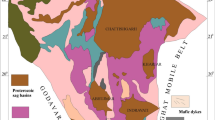Summary
The number, morphological details and structure of ostracod shells washed from chalk by mechanical disaggregation differ from those in siliceous chalk treated by hydrofluoric acid (HF, conc.). The shells studied are from erratic material (Ger. “Schollen”, “Geschiebe”) of young Quaternary deposits from Nossentin near Malchow/Mecklenburg, NE Germany; Wicko (Vietzig) near Miedzyzdroje (Misdroy), Isle of Wolin/Baltic Sea, NW Poland (Upper Turonian) and from outcropping chalk (Lower Maastrichtian) of the Island of Rügen/Baltic Sea, NE Germany as well as erratic boulders (Upper Maastrichtian), NE Germany.
The differences in the number of shells and their state of preservation are primarily caused by biotic and nonbiotic influences after death, e.g. loss of organic substance and shell deformation by low pressure. Greater destruction of the shell and its sculpture is caused by pressure (sedimentary compaction), recrystallization, sparitization and accretine crystallization of the shell calcite during diagenesis. The silification process or origin of flint in chalk is caused by weakly acidic environmental conditions (pH<5) before sedimentary compaction. It is indicated by dispersed pyrite and by well-preserved siliceous radiolarian skeletons. Finely-foliated opal-CT crystals start growing between the crystallites of the ostracod shell, later on forming lepispheres. Silification is early diagenetic, as verified by the well-preserved shell sculpture and structure and the undisturbed bioturbate structure in siliceous nodules.
Similar content being viewed by others
References
Alexandrowicz, Z. (1966): Utwory kredowe w krach glacjalnych na wyspie Wolin i w okolocy Kamienia Pomorskiego.—Polska Akad. Nauk, Prace Geol.35, 103 p., 33 Figs., 33 fotos, Warszawa
Bate, R.H., &East, B.A. (1972): The structure of the ostracode carapace.—Lethaia5/2, 177–194, 11 Figs., Oslo
Behrens, G. (1878): Über Kreideablagerungen auf der Insel Wollin.— Z. deutsch. geol. Ges.30, 229–267, Pls. 10–11, Berlin
Deecke W. (1907): Geologie von Pommem.—302 p., 40 Figs., Berlin
Geinitz, F.E. (1883): Die Flözformationen Mecklenburgs. Kreide: VI. Die Kreidelager am Müritz- und Fleesensee; IX. geologisches Alter der Mecklenburgischen Kreide.—Archiv Ver. Freunde Naturgesch. Mecklenburg37, 71–76, 83–86, Neubrandenburg
— (1886): Das Kalklager von Nossentin.—Mitt. Großherzogl. Meckl. Geol. Landesamt6, 3–5, 1 pl., Rostock
Geinitz, F.E. (1922): Geologie Mecklenburgs. Teil II. Das ältere Gebirge 168 p., Rostock
Herrig, E. (1975): Über Schalen-Inkrustationen bei Ostracoden (Crustacea).—Z. geol. Wiss.3/5, 671–685, 6 Figs., Pls. 1–3, Berlin
— (1982): Zur Erhaltung von kalkschaligen Mikrofossilien in verkieselten Sedimenten, dargestellt am Flint der Schreibkreide (Unter-Maastricht) der Insel Rügen (Ostsee).—Z. geol. Wiss., 10/10, 1357–1379, 5 Figs., 7 Pls., Berlin
— (1987): Zur taxonomischen Bewertung schalenmorphologischer Details bei marinen postpaläozoischen Ostracoden (Crustacea).— Z. geol. Wiss.,15/6, 739–752, 1 Fig., 5 Pls., Berlin
— (1988a): Morphologische Veränderungen an calcitischen Mikrofossilschalen, speziell Ostrakoden, bei mechanischer Gesteinsaufbereitung.—Z. geol. Wiss.,16/5, 447–459, 1 Fig., 1 Tab., 5 Pls., Berlin
— (1988b): Neue Ostrakoden aus Geschieben. Punciide Ostrakoden aus der höheren Oberkreide der Mittleren Ostsee.— Geschiebekde. aktuell4/2, 33–37, 8 Figs., Hamburg
— (1991): Neue Ostrakoden aus verkieselten Kalksteinen der höheren Oberkreide (Ober Maastricht) der Dänisch-Polnischen Furche/Ostsee, II.—Geol. Jb. A128, 99–115, 2 Figs., 2 Pls., Hannover
— (1992): Neue Ostracoden aus verkieselten Kalksteinen der höheren Oberkreide (Ober-Maastricht) der Dänisch-Polnischen Furche/Ostsee.-I.—Z. geol. Wiss.20/1–2, 27–49, 8 Figs., 4 Pls., Berlin
— (1992): Die erste Radiolarie aus der Schreibkreide (Unter-Maastrichtium) der Insel Rügen (Ostsee).—Geschiebekde. aktuell,8/1, 21–24, 1 Fig., Hamburg
Kalkowsky, E. (1901): Die Verkieselung der Gesteine in der nördlichen Kalahari.—Sitz.-Ber. u. Abh. Nat. Ges. Isis, Dresden
Millot, G. (1960): Silice, silex, silifications et croissance des cristaux.—Bull. Serv. Carte géol. Als. Lorr.13/4, 129–146
Nötzold, T. (1965): Die Präparation von Gyrogoniten und kalkigen Charophyten-Oogonien aus festen Kalksteinen.—Monatsber. dt. Akad. Wiss. Berlin7/3, 216–221, 2 Pls., Berlin
Richter, K. (1933): Die Bodenschätze Pommerns. In: 25 Jahre Pommersche geologische Landessammlung.—Mitt. Geol.— palaeont. Inst. Univ. Greifswald9, 19–49, 12 Figs., Greifswald
Schallreuter, R. (1983): Mikrofossilien aus Geschieben. III. Gewinnung.—Geschiebesammler16/3–4, 113–114, 3 Figs., 3 Pls., Hamburg
Scholz, R. W. (1970): Zur Sedimentologie und Kompaktion der Schreibkreide von Lägerdorf in SW-Holstein.—Ph.D. Thesis. Univ. Hamburg, 44 p., 10 Figs., Hamburg
Tada, A. &Iijima, A. (1983): Petrology and diagenetic changes of Neogene siliceous rocks in northern Japan.—J. Sed. Petrol.53, 911–930, Tulsa
Towe, K. H. &Cifelli, R. (1967): Wall ultrastructure in the calcareous Foraminifera: crystallographic aspects and a model for calcification.—J. Paleont.41/3, 742–762, Pls. 87–99, Menasha
Author information
Authors and Affiliations
Rights and permissions
About this article
Cite this article
Herrig, E. The preservation of ostracod shells in the siliceous chalk of the Danish-Polish Furrow (Baltic Sea). Facies 28, 77–86 (1993). https://doi.org/10.1007/BF02539729
Received:
Accepted:
Issue Date:
DOI: https://doi.org/10.1007/BF02539729




